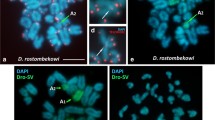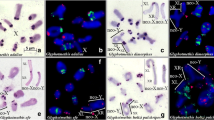Abstract
Harttia is a genus of the subfamily Loricariinae that posses a broad chromosomal variation. In addition to interspecific karyotype diversity within this group, a multiple sex chromosome system, XX/XY1Y2, has been described for Harttia carvalhoi. Thus, this study aimed to determine the role of chromosomal rearrangements in karyotype differentiation in Harttia by classical and molecular cytogenetic procedures. The results show that Robertsonian rearrangements have a prominent role in the chromosomal diversification of the species analysed, which initially leads to hypothesize a diploid number reduction in Harttia torrenticola and H. carvalhoi. The metacentric chromosome 1, shared between H. torrenticola and H. carvalhoi, could have originated from centric fusions from the ancestral karyotype. A centric fission event associated with the first metacentric pair allowed for the origination of a multiple sex chromosome system XX/XY1Y2, specific to H. carvalhoi. This study highlights the relevance of Robertsonian rearrangements in karyotypic differentiation of the species studied and demonstrates that the occurrence of a centric fission, as opposed to a previously hypothesised chromosome fusion, is directly implicated in the origin of the sex chromosome system of H. carvalhoi.


Similar content being viewed by others
References
Alves AL, Oliveira C, Foresti F (2003) Karyotipe variability in eight species of the subfamilies Loricariinae and Ancistrinae (Teleostei, Siluriformes, Loricariidae). Caryologia 56:57–63
Artoni RF, Bertollo LAC (2001) Trends in the karyotype evolution of Loricariidae fish (Siluriformes). Hereditas 134:201–210
Bellafronte E, Schemberger MO, Moreira-Filho O, Almeida MC, Artoni RF, Margarido VP, Vicari MR (2011) Chromosomal markers and phylogenetic inferences among species of Parodontidae. Rev Fish Biol Fish 21:559–570
Bertollo LAC, Takahashi CS, Moreira-Filho O (1978) Cytotaxonomic considerations on Hoplias lacerdae (Pisces, Erythrinidae). Braz J Genet 2:103–120
Brassesco MS, Pastori MC, Roncati HÁ, Fenocchio AS (2004) Comparative cytogenetic studies of Curimatidae (Pisces, Characiformes) from the middle Paraná river (Argentina). Genet Mol Res 3:293–301
Bueno V, Zawadzki CH, Margarido VP (2012) Trends in chromosome evolution in the genus Hypostomus Lacépède, 1803 (Osteichthyes, Loricariidae): a new perspective about the correlation between diploid number and chromosomes types. Rev Fish Biol Fish 22(1):241–250
Centofante L, Bertollo LAC, Moreira-Filho O (2006) Cytogenetic characterization and description of an XX/XY1Y2 sex chromosome system in catfish Harttia carvalhoi (Siluriformes, Loricariidae). Cytogenet Genome Res 112:320–324
Costa-Silva GJ (2009) Análise filogenética entre gêneros da subfamília Loricariinae (Siluriformes: Loricariidae) com ênfase no gênero Harttia, baseada em caracteres moleculares. Dissertation, Universidade Estadual de São Paulo
Feldberg E, Porto JIR, Bertollo LAC, Nakayama CM (1993) Karyotype evolution in Curimatidae (Teleostei, Characiformes) from the amazon region. II. Centric fissions in the genus Potamorhina. Genome 36:372–376
Foresti F, Oliveira C, Almeida-Toledo LF (1993) A method for chromosome preparations from large specimens of fishes using ‘in vitro’ short treatment with colchicine. Experientia 49:810–813
Griffiths SP (2000) The use of clove oil as an anaesthetic and method for sampling intertidal rockpool fishes. J Fish Biol 57:1453–1464
Hatanaka T, Galetti PM Jr (2004) Mapping of the 18S and 5S ribosomal RNA genes in the fish Prochilodus argenteus Agassiz, 1829 (Characiformes, Prochilodontidae). Genetica 122:239–244
Howell WM, Black DA (1980) Controlled silver-staining of nucleolus organizer regions with a protective colloidal developer: a 1-step method. Experientia 36:1014–1015
Ijdo JW, Wells RA, Baldini A, Reeders ST (1991) Improved telomere detection using a telomere repeat probe (TTAGGG)n generated by PCR. Nucleic Acids Res 19:4780
Kavalco KF, Pazza R, Bertollo LAC, Moreira-Filho O (2004) Heterochromatin characterization of four fish species of the family Loricariidae (Siluriformes). Hereditas 141:237–242
Kavalco KF, Pazza R, Bertollo LAC, Moreira-Filho O (2005) Karyotypic diversity and evolution of Loricariidae (Pisces, Siluriformes). Heredity 94:180–186
Levan A, Fredga K, Sandberg AA (1964) Nomenclature for centromeric position on chromosomes. Hereditas 52:201–220
Lui RL, Blanco DR, Margarido VP, Moreira-Filho O (2009) First description of B chromosomes in the family Auchenipteridae, Parauchenipterus galeatus (Siluriformes) of the São Francisco river basin (MG, Brazil). Micron 40:552–559
Mariotto S, Centofante L, Vicari MR, Artoni RF, Moreira-Filho O (2011) Chromosomal diversification in ribosomal DNA sites in Ancistrus Kner, 1854 (Loricariidae, Ancistrini) from three hydrographic basins of Mato Grosso, Brazil. CompCytogen 5:289–300
Martins C, Galetti PM Jr (1999) Chromosomal localization of 5S DNA genes in Leporinus fish (Anostomidae, Characiformes). Chromosom Res 7:363–367
Moreira-Filho O, Bertollo LAC, Galetti PM Jr (1980) Evidences for a multiple sex chromosome system with female heterogamety in Apareiodon affinis (Pisces, Parodontidae). Caryologia 33:83–91
Moreira-Filho O, Bertollo LAC, Galetti PM Jr (1993) Distribution of sex chromosome mechanisms in Neotropical fish and description of a ZZ/ZW system in Parodon hilarii (Parodontidae). Caryologia 46:115–125
Oliveira C, Foresti F, Hilsdorf AWS (2009) Genetics of neotropical fish: from chromosomes to populations. Fish Physiol Biochem 35:81–100
Perry J, Slater HR, Choo KHA (2004) Centric fission—simple and complex mechanisms. Chromosom Res 12:627–640
Pinkel D, Straume T, Gray J (1986) Cytogenetic analysis using quantitative, high-sensitivity, fluorescence hybridization. Proc Natl Acad Sci USA 83:2934–2938
Rosa KO, Ziemniczak K, Barros AV, Nogaroto V, Almeida MC, Cestari M M, Artoni RF, Vicari MR (2011) Numeric and structural chromosome polymorphism in Rineloricaria lima (Siluriformes, Loricariide): fusion points carrying 5S rDNA or telomere sequence vestiges. Rev Fish Biol Fish doi:10.1007/s11160-011-9250-6
Schemberger MO, Bellafronte E, Nogaroto V, Almeida MC, Schuhli GS, Artoni RF, Moreira-Filho O, Vicari MR (2011) Differentiation of repetitive DNA sites and sex chromosome systems reveal closely related group in Parodontidae (Actinopterygii: Characiformes). Genetica 139:1499–1508
Sumner AT (1972) A simple technique for demonstrating centromeric heterochromatin. Exp Cell Res 75:304–306
Ziemniczak K, Barros AV, Rosa KO, Nogaroto V, Almeida MC, Cestari MM, Moreira-Filho O, Artoni RF, Vicari MR (2012) Comparative cytogenetics of Loricariidae (Actinopterygii: Siluriformes): emphasis in Neoplecostominae and Hypoptopomatinae. Ital J Zool doi:10.1080/11250003.2012.676677
Acknowledgments
The authors are grateful to Osvaldo Takeshi Oyakawa (MZUSP) for the identification of the specimens; to Luis Henrique da Silva and Pedro Luis Gallo for help with the sampling; to the Instituto Brasileiro do Meio Ambiente e dos Recursos Naturais Renováveis (IBAMA—License number: 10538-1) and the Instituto Estadual de Florestas (IEF/MG) for authorization to collect the material. This study was financed by the Fundação de Amparo à Pesquisa do Estado de São Paulo (FAPESP), Conselho Nacional de Desenvolvimento Científico e Tecnológico (CNPq), Coordenação de Aperfeiçoamento de Pessoal de Nível Superior (CAPES) and the Fundação Araucária (Fundação Araucária de Apoio ao Desenvolvimento Científico e Tecnológico do Estado do Paraná).
Author information
Authors and Affiliations
Corresponding author
Rights and permissions
About this article
Cite this article
Blanco, D.R., Vicari, M.R., Lui, R.L. et al. The role of the Robertsonian rearrangements in the origin of the XX/XY1Y2 sex chromosome system and in the chromosomal differentiation in Harttia species (Siluriformes, Loricariidae). Rev Fish Biol Fisheries 23, 127–134 (2013). https://doi.org/10.1007/s11160-012-9283-5
Received:
Accepted:
Published:
Issue Date:
DOI: https://doi.org/10.1007/s11160-012-9283-5




